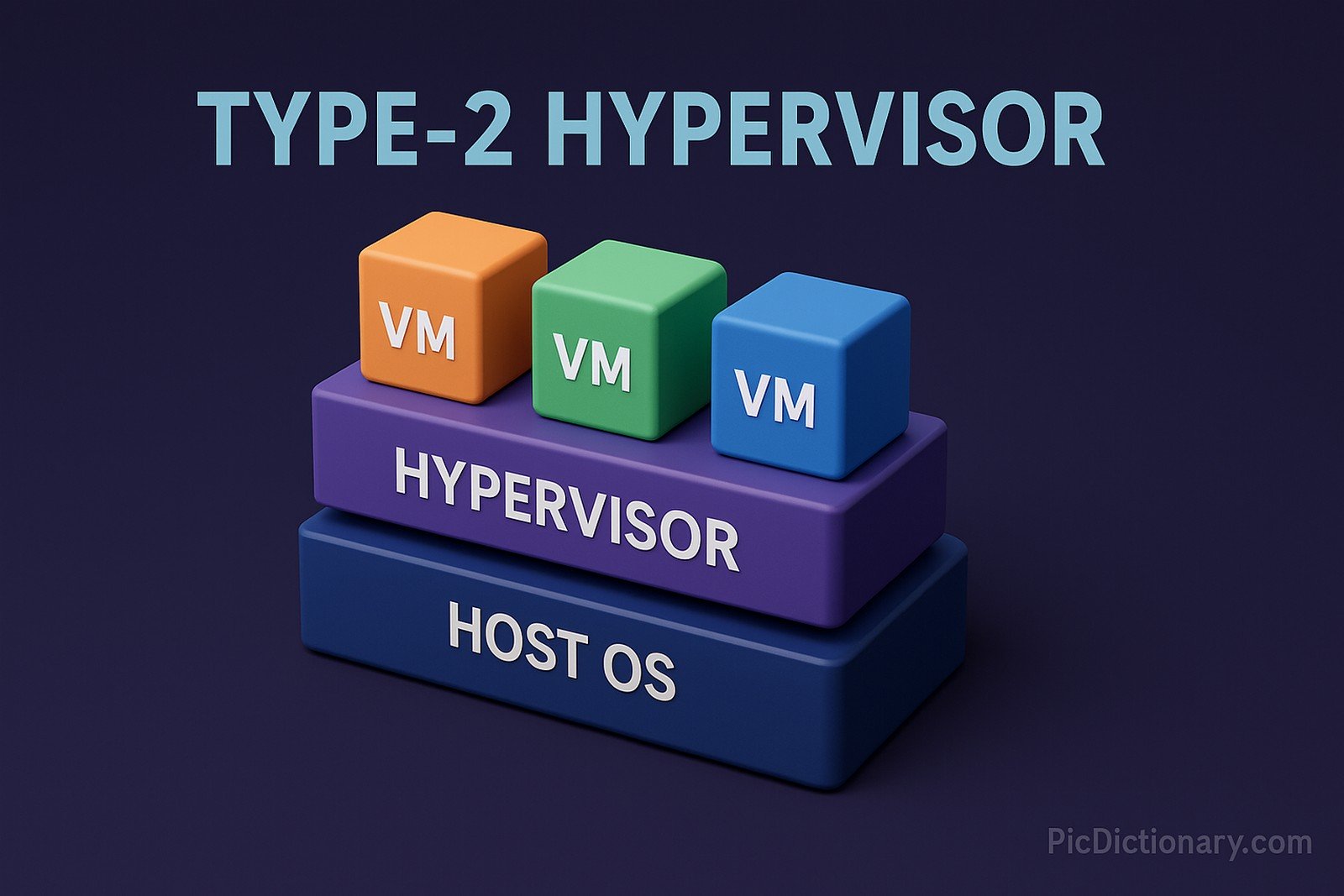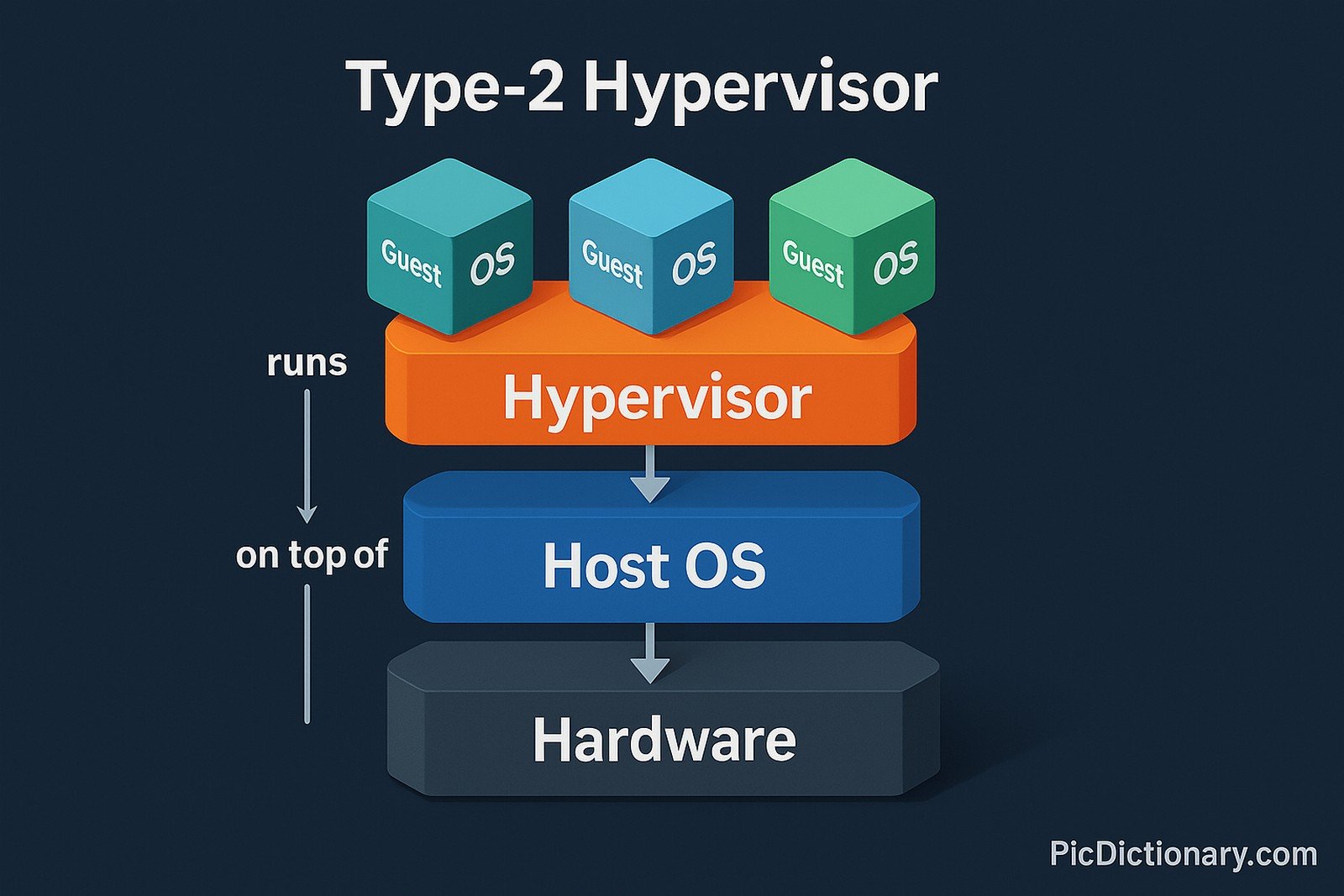Type-2 Hypervisor

Quick Navigation:
- Type-2 Hypervisor Definition
- Type-2 Hypervisor Explained Easy
- Type-2 Hypervisor Origin
- Type-2 Hypervisor Etymology
- Type-2 Hypervisor Usage Trends
- Type-2 Hypervisor Usage
- Type-2 Hypervisor Examples in Context
- Type-2 Hypervisor FAQ
- Type-2 Hypervisor Related Words
Type-2 Hypervisor Definition
A Type-2 Hypervisor, also known as a hosted hypervisor, is a virtualization software layer that runs on top of an existing operating system. Unlike Type-1 hypervisors that operate directly on hardware, Type-2 hypervisors depend on the host OS for resource management and device interactions. They enable users to run multiple virtual machines (VMs) simultaneously, each with its own guest operating system. Popular examples include Oracle VirtualBox, VMware Workstation, and Microsoft Hyper-V (in client mode).
Type-2 Hypervisor Explained Easy
Imagine your computer is like a house, and your operating system is the foundation. A Type-2 Hypervisor is like a room inside the house where you can build small, separate apartments (virtual machines). These apartments have their own rules (guest OS) but still rely on the main house (host OS) for electricity, water, and other services.
Type-2 Hypervisor Origin
The concept of hypervisors dates back to the 1960s, with IBM’s early virtualization efforts. However, Type-2 hypervisors became prominent in the 2000s as personal computers grew more powerful. Companies like VMware, Microsoft, and Oracle developed user-friendly virtualization software for desktop and enterprise applications.
Type-2 Hypervisor Etymology
The term "hypervisor" originates from the word "supervisor," a term used in computing to describe software that manages other software. The "Type-2" classification differentiates it from the more hardware-integrated Type-1 hypervisors.
Type-2 Hypervisor Usage Trends
Type-2 hypervisors are widely used for software testing, development, and running applications that require different operating systems. With the rise of cloud computing and containerization, their role has shifted more towards personal use and niche enterprise applications. However, they remain crucial for developers needing isolated test environments.
Type-2 Hypervisor Usage
- Formal/Technical Tagging:
- Virtualization
- Software Development
- System Testing - Typical Collocations:
- "run a VM using a Type-2 Hypervisor"
- "host OS compatibility for Type-2 Hypervisors"
- "Type-2 Hypervisor for software testing"
- "deploying virtual machines on a hosted hypervisor"
Type-2 Hypervisor Examples in Context
- A software engineer uses a Type-2 Hypervisor to test an application on Linux while running Windows as the host OS.
- Cybersecurity researchers create isolated environments using Type-2 Hypervisors to analyze malware safely.
- A student learning operating systems installs a Type-2 Hypervisor to experiment with different distributions of Linux.
Type-2 Hypervisor FAQ
- What is a Type-2 Hypervisor?
A Type-2 Hypervisor is a virtualization software that runs on top of an existing operating system to create and manage virtual machines. - How does a Type-2 Hypervisor differ from a Type-1 Hypervisor?
A Type-2 Hypervisor relies on a host OS, while a Type-1 Hypervisor runs directly on hardware without an intermediary OS. - What are some popular Type-2 Hypervisors?
Examples include Oracle VirtualBox, VMware Workstation, and Microsoft Hyper-V (client mode). - Can I run macOS on a Type-2 Hypervisor?
Running macOS on a Type-2 Hypervisor is possible but often restricted by Apple's licensing policies. - Is a Type-2 Hypervisor suitable for enterprise environments?
While commonly used for development and testing, enterprises generally prefer Type-1 Hypervisors for production environments due to better performance. - Does using a Type-2 Hypervisor slow down my computer?
Since it runs on a host OS, a Type-2 Hypervisor may introduce some performance overhead compared to direct hardware access. - Can I run multiple VMs on a Type-2 Hypervisor at the same time?
Yes, but performance depends on your system’s resources such as RAM and CPU power. - Is a Type-2 Hypervisor secure?
It is secure for general use, but since it relies on a host OS, it inherits any security vulnerabilities of that OS. - Do Type-2 Hypervisors support GPU acceleration?
Some, like VMware Workstation and VirtualBox, offer limited GPU passthrough support, but it is not as efficient as on Type-1 Hypervisors. - Can I use a Type-2 Hypervisor for gaming?
It’s possible but not ideal, as virtualized environments typically do not provide the same performance as running games natively on hardware.

Type-2 Hypervisor Related Words
- Categories/Topics:
- Virtualization
- Operating Systems
- Cloud Computing
Did you know?
The first commercial Type-2 Hypervisor, VMware Workstation, was released in 1999, marking a major milestone in personal virtualization. Today, it remains one of the most popular choices for running multiple OS instances on a single machine.
PicDictionary.com is an online dictionary in pictures. If you have questions or suggestions, please reach out to us on WhatsApp or Twitter.Authors | Arjun Vishnu | @ArjunAndVishnu

I am Vishnu. I like AI, Linux, Single Board Computers, and Cloud Computing. I create the web & video content, and I also write for popular websites.
My younger brother, Arjun handles image & video editing. Together, we run a YouTube Channel that's focused on reviewing gadgets and explaining technology.



Comments powered by CComment